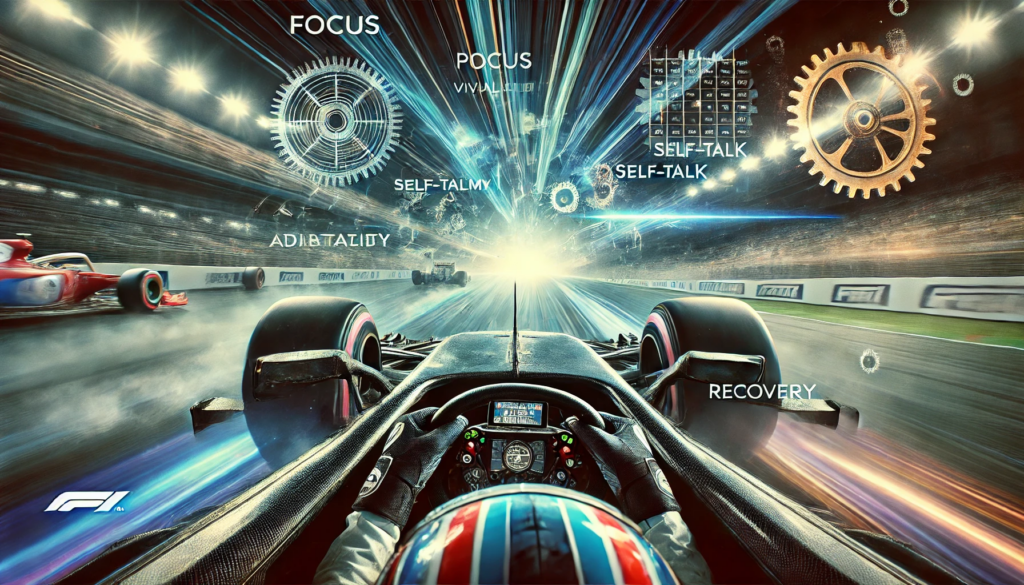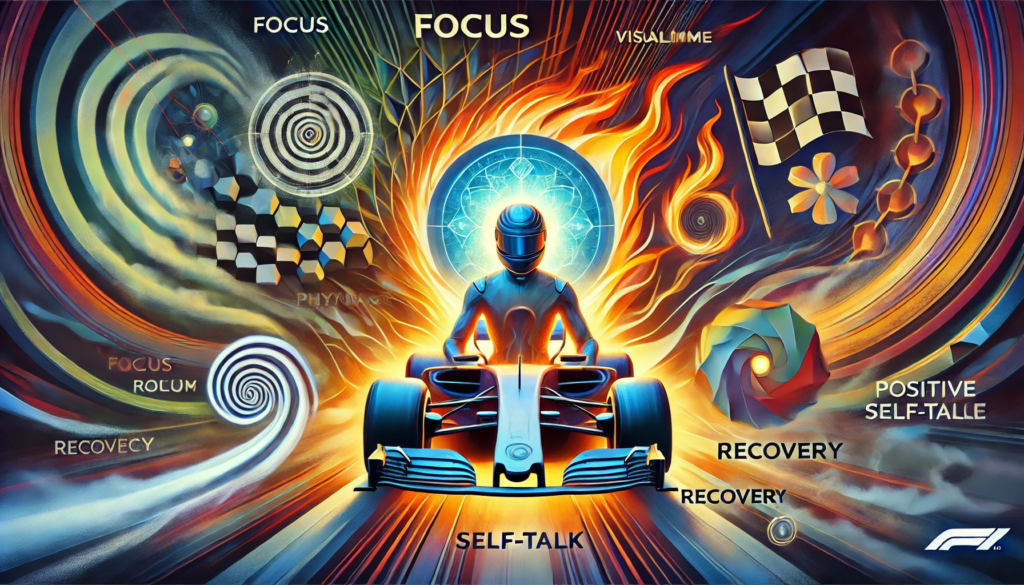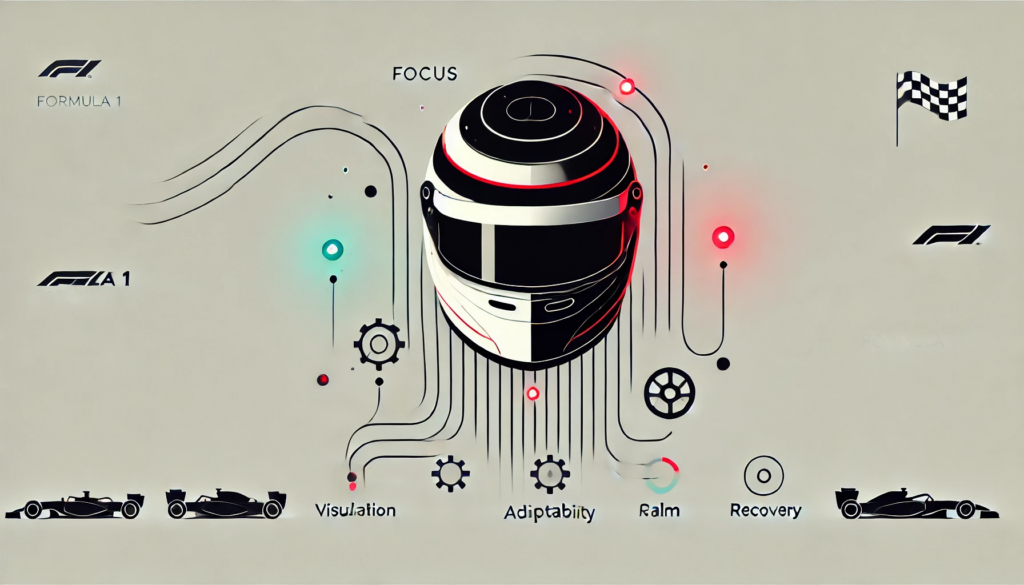
ChatGPT:
How to Focus Like a Formula 1 Driver: In-Depth Analysis
🏎️ Introduction
Formula 1 (F1) racing demands unparalleled focus and precision. Drivers must navigate courses at breakneck speeds, responding instantaneously to evolving conditions while managing intense physical and mental pressures. These high-performance athletes rely on a mental toolkit honed by rigorous training, visualization, and resilience. This expanded summary delves deeper into the strategies F1 drivers use to sustain peak focus and performance and explores how you can apply these techniques to your everyday tasks.
🧠 Mental Strategies from Formula 1
🛠️ 1. Visualization: Preparing the Mind for Success
F1 drivers prepare for races by simulating scenarios and mentally rehearsing them. This process ensures their responses are automatic, leaving mental bandwidth for unexpected challenges.
• What it involves: Drivers recreate race conditions as realistically as possible. For instance, they mentally picture the feel of the steering wheel or the proximity of other cars. Oscar Piastri spends a full day in a simulator before every race, fine-tuning his mental responses to the track’s twists and turns.
• How you can use it: For tasks like presentations or interviews, imagine the environment—what you’ll see, hear, and experience. By visualizing success, you reduce uncertainty and build confidence.
🗣️ 2. The Power of Positive Self-Talk
Drivers use specific language cues to maintain focus and motivation. Self-talk can be either instructional (“Brake earlier at this corner”) or motivational (“You’ve got this”). Negative self-talk, on the other hand, hinders performance.
• Key insight: Instructions like “Don’t crash” focus the brain on what to avoid, increasing the risk of failure. Instead, use affirmations like “Smooth through the exit” to guide your actions positively.
• Application: Develop personal mantras or reminders for stressful situations, ensuring they focus on what you want to achieve rather than what you fear.
🌩️ 3. Adaptability: Embracing Uncertainty
The dynamic nature of F1 racing demands constant adaptability. Piastri emphasizes accepting uncontrollable variables, such as weather, pit stop delays, or other drivers’ actions.
• Practical tip: Anticipate potential disruptions and plan for quick recovery. For example, during a challenging meeting, remind yourself to stay calm and refocus on actionable tasks rather than dwelling on what went wrong.
• Mindset: Acceptance reduces emotional reactivity, allowing you to stay composed under pressure.
🔄 Shifting Focus Strategically
🧩 4. Diversifying Attention
During a race, drivers shift attention dynamically between the road, their car’s performance, track conditions, and radio communications. This variability prevents mental fatigue and enhances situational awareness.
• Why it works: The human brain naturally craves variation to avoid monotony. Momentarily redirecting focus to related sub-tasks refreshes mental energy.
• Practical use: In a long meeting or work session, pause to check your notes, analyze others’ reactions, or reorganize your workspace. These micro-shifts help maintain engagement without losing sight of the main objective.
🌟 Finding Flow and Motivation
5. Harnessing Intrinsic Motivation
Flow states—periods of effortless concentration—are often achieved when tasks are meaningful and aligned with personal goals. Piastri reports finding flow more easily on challenging circuits, where the complexity keeps his mind fully engaged.
• Flow triggers: Tasks that are challenging but achievable stimulate engagement. Avoid tasks that are too simple (boring) or too difficult (frustrating).
• Personal insight: Connect routine tasks to larger goals. For example, when cleaning your workspace, visualize how the result will enhance productivity.
🛑 Recharge for Long-Term Performance
🌞 6. The Importance of Breaks
Dr. Robbie Anderson emphasizes the critical role of rest in sustaining performance. Breaks allow the brain’s prefrontal cortex—responsible for attentional control—to recover from stress.
• Scientific evidence: A study involving simulated rail control tasks found that all five types of break activities tested improved post-break performance compared to no break at all.
• Your takeaway: Schedule intentional breaks throughout your workday. Use these moments to relax, refocus, and return to your task with renewed clarity.
👨🔬 Practical Applications in Everyday Life
7. Mindfulness and Cognitive Control
F1 drivers rehearse mindfulness techniques by refocusing attention during simulated runs. This mirrors meditation practices, which strengthen cognitive flexibility and attentional control.
• Example: If you find your mind wandering, gently redirect your attention to the task at hand, much like a meditator returning focus to their breath.
8. Resilience in High-Stakes Situations
Mental resilience gives drivers a competitive edge when the stakes are high. After a mistake or setback, they use self-regulation techniques to recover quickly.
• For you: In stressful moments, adopt the mantra, “That happened—just move forward.” This approach minimizes emotional fallout and keeps you focused on solutions.
9. Build Mental Toughness Through Review
Dr. Anderson divides performance improvement into four phases: preparation, execution, review, and recovery. Post-task reflection helps identify what worked and what didn’t, setting the stage for future growth.
• Actionable tip: After completing a significant task, review your performance. Identify one success to celebrate and one area for improvement.
🏁 Final Insights
Formula 1 drivers exemplify peak mental performance through techniques that are surprisingly accessible for everyday challenges. Visualization, positive self-talk, adaptability, focus variability, intrinsic motivation, and recovery are the cornerstones of their success. By incorporating these strategies into your routine, you can improve focus, resilience, and overall productivity.
🌟 Takeaways
• Prepare mentally: Use visualization and simulations to reduce uncertainty.
• Use affirmations: Replace negative thoughts with clear, constructive language.
• Stay adaptable: Anticipate challenges and maintain composure under pressure.
• Shift focus: Vary your attention within tasks to sustain engagement.
• Recharge regularly: Breaks are essential for reducing stress and boosting performance.

FAQs
Q: What is the main focus of Formula 1 drivers’ mental strategies?
A: The main focus is on maintaining intense concentration, adaptability, and resilience during high-pressure situations. Drivers use visualization, positive self-talk, mindfulness, and recovery techniques to optimize their performance.
Q: How does visualization help in focusing?
A: Visualization helps drivers mentally rehearse scenarios, making their responses automatic during races. It reduces uncertainty and builds confidence by creating a detailed mental picture of what to expect.
Q: What is self-talk, and why is it important?
A: Self-talk refers to the internal dialogue drivers use to stay focused and motivated. Positive, instructional cues help guide their actions, while avoiding negative self-talk prevents distractions and mistakes.
Q: How can I apply adaptability in everyday situations?
A: Adaptability involves accepting uncontrollable factors and quickly refocusing on what you can control. For example, if a meeting doesn’t go as planned, focus on actionable next steps instead of dwelling on setbacks.
Q: What are flow states, and how can I achieve them?
A: Flow states occur when you’re fully immersed in a task that challenges your skills without overwhelming you. To achieve flow, choose tasks that align with your goals, offer a manageable challenge, and hold intrinsic value.
Q: Why are breaks essential for focus?
A: Breaks reduce stress, recharge mental energy, and allow the brain’s attentional systems to recover. Research shows that even short breaks improve performance on focus-intensive tasks.
Q: How do Formula 1 drivers handle distractions?
A: Drivers strategically shift attention to related tasks, such as monitoring car performance or track conditions, to prevent zoning out. This approach keeps them engaged and prevents mental fatigue.
Q: What is the role of mindfulness in maintaining focus?
A: Mindfulness trains the brain to redirect attention when it deviates from a task. F1 drivers rehearse mindfulness by repeatedly refocusing during simulated runs, improving their cognitive control.
Q: How can I build resilience like a Formula 1 driver?
A: Building resilience involves accepting mistakes, using positive self-talk, and quickly refocusing on solutions. Practicing mental recovery techniques, such as breathing exercises, also helps.
Q: Can these strategies work outside of high-pressure scenarios?
A: Absolutely. Visualization, self-talk, adaptability, and recovery can enhance focus, productivity, and resilience in everyday tasks like presentations, interviews, or long work sessions.

